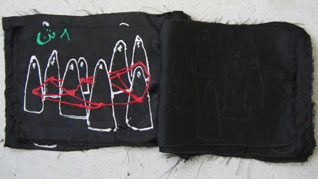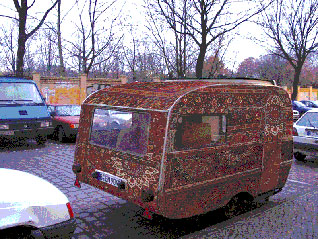 |
|
Art
and Text I:
Opening:
31 August 8pm |
|||||||||||||
|
Farkhondeh Shahroudi Art Laboratory Berlin is pleased to present a solo exhibition of book art, drawings and a digital work by Farkhondeh Shahroudi as part of the series Art and Text. Born in Tehran in 1962, Shahroudi has lived in Germany since 1990. She is both a visual artist working in a variety of media:sculpture, drawing, painting, photography, video and computer. Her work indeed functions like a series of hyperlinks between art and text, between tradition and technology. Her two artist books from the series The Book in Book (2001-2007), are hand painted on fabric. Each is unique, referring back to the pre-Gutenberg traditions of illuminated manuscripts and to classical Persian miniatures. Both books are filled with the images of women veiled in the traditional Iranian chador. Shahroudi's use of different fabrics for the book's pages, with their opacity or transparency, challenges our preconceived cultural notions both in terms of material substance and subject matter. By cutting away parts of pages, she creates in her own words "windows and doors" within the artwork. In contrast to the mechanically produced artwork or book, which according to Benjamin's dictum, loses its 'aura' through mass production, the uniqueness of Shahroudi's hand-made books in effect loads them with a special 'aura' similar to that of a relic or fetish. She sees the artwork as "an object which functions as a carrier of meaning." Her recent series of drawings, Glossolalie (2007), started as an experiment. Right-handed, she made a series of drawings on paper with her left hand. She then painted these images onto fragments of cloth which were cut from a previously unfinished artwork: a cloth which was covered with layers of writing in Farsi. Shahroudi uses a formula for creating the 'illegible' texts found in many of her artworks. She often writes spontaneous texts, similar to the automatic writing of the Surrealists, and then continues writing over them several times with further texts. The result is simultaneously illegible and (at least phonetically) partially recognisable. It is a mixture of image, calligraphy, lost meaning, and half hidden sound. In her use of writing, sewing, painting (and working on computer) the movement of the hand replaces the voice as the main linguistic medium. "When I work with my hands, it is as if my tongue is working through my hands." The digital projection Gülüzar (2005) is a photo-collage of a camping wagon parked in front of Kreuzberg's Görlitzer Park (which is nicknamed Gülüzar - flower meadow - by the local Turkish community). The wagon appears to be upholstered with a Persian carpet. Both the carpet and its symbolic role as mobile garden are a major motif in Shahroudi's work. In her performance Restituzione in Rome's Tiburtina railway station (2003) she distributed fragments of carpets to bewildered passers-by. In 2005 she wrapped the columns of the Haus der Kulturen der Welt in Berlin with Persian carpets. The garden is a common theme in classical Persian art and poetry. It is also the major motif in the oriental carpet, whose designs usually refer to trees and flora. Furthermore, the carpet as mobile artwork, mobile garden is the perfect symbol for an artist working ex-patria. Christian
de Lutz |
||||||||||||
| sponsored by: | |||||
| Mitte
Museum am Gesundbrunnen |
|||||

